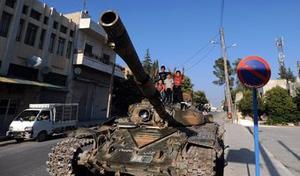Chemical weaponsSyria arms dozens of chemical aerial bombs
President Assad has taken the last step required for using chemical weapons: over the weekend the Syrian military begun to move chemical weapons from their storage areas to military bases where the delivery vehicles of these weapons – planes, tanks, and artillery – are stationed; on Tuesday and Wednesday the Syrian military has taken the second step required before chemical weapon deployment: its engineers have begun to mix the chemicals of these binary weapons, making them operational; the bombs have been placed in hangars next to the planes which will carry them to target – and it would now be a matter of minutes from Assad ordering the use of these weapons to planes dropping them on their targets

Syria has moved chemical munitions from storage to delivery systems // Source: bokra.net
The Assad regime’s days are now numbered. The majority of the country’s territory – analyst estimate this to be around 60-70 percent – is no longer under government control; fighting is taking place on the outskirts of the major cities; and, most worrisome for the regime, Jordan and Qatar, with U.S. blessing, have begun to provide some of the rebel groups with shoulder-fired anti-aircraft missiles, offering the rebels a measure of protection against the regime’s air superiority.
In desperation, the beleaguered regime has now moved to operationalize some of its vast stocks of chemical weapons.
As we reported on Monday, the Syrian military, over the weekend, begun to move chemical weapons from their storage areas to military bases where the delivery vehicles of these weapons – planes, tanks, and artillery – are stationed.
On Tuesday and Wednesday, the Syrian military has taken the second step required before chemical weapon deployment: its engineers have begun to mix the chemicals of these binary weapons, making them operational.
NBC reports that the military, on Tuesday and Wednesday, has loaded the precursor chemicals for the nerve gas sarin into aerial bombs. The bombs, however, have not yet been loaded onto planes.
The Assad regime has thus completed the three steps required for chemical weapons use: the chemicals have been moved out of storage; the chemicals have then been loaded into bombs; and the bombs have been placed in hangars next to the planes which will carry them to target. It would now be a matter of minutes from Assad ordering the use of these weapons to planes dropping them on their targets.
In 1998 Saddam Hussein used sarin against the Kurdish villagers in Halabja, killing 5,000.
Syria has the world’s largest arsenal of chemical weapons, and the most active chemical weapons production lines. In addition to sarin, Syria has also large stocks of tabun, a chemical nerve agent, as well as traditional chemical weapons like mustard gas and hydrogen cyanide.
Syria is one of only seven nations which have not joined the 1992 Chemical Weapons Convention.
The Syrian military can deliver chemical weapons in several ways. Bombs filled with chemicals can be carried by Syrian Air Force fighter-bombers like Sukhoi-22/20, MiG-23, and Sukhoi-24 aircraft.
The unguided short-range Frog-7 artillery rockets is also capable of carrying chemical payloads.
Syria also has longer range missiles capable of carrying a chemical payload: a few dozen SS-21 ballistic missiles with a maximum range of 72 miles; 200 Scud-Bs, with a maximum range of 180 miles; and 60 to 120 Scud-Cs, with a maximum range of 300 miles. All these missiles are mobile.
A senior U.S. official told Fox News that once bombs have been loaded with components of sarin gas, the Syrian forces have sixty days to use these bombs until the chemical mixture expires and has to be destroyed.
In Brussels yesterday, U.S. Secretary of State Hillary Clinton again expressed concerns that “an increasingly desperate Assad regime might turn to chemical weapons” or lose control of them to militant groups.
She also said NATO’s decision on Tuesday to send Patriot missile batteries to Turkey’s southern border with Syria sends a message that Ankara is backed by its allies.
